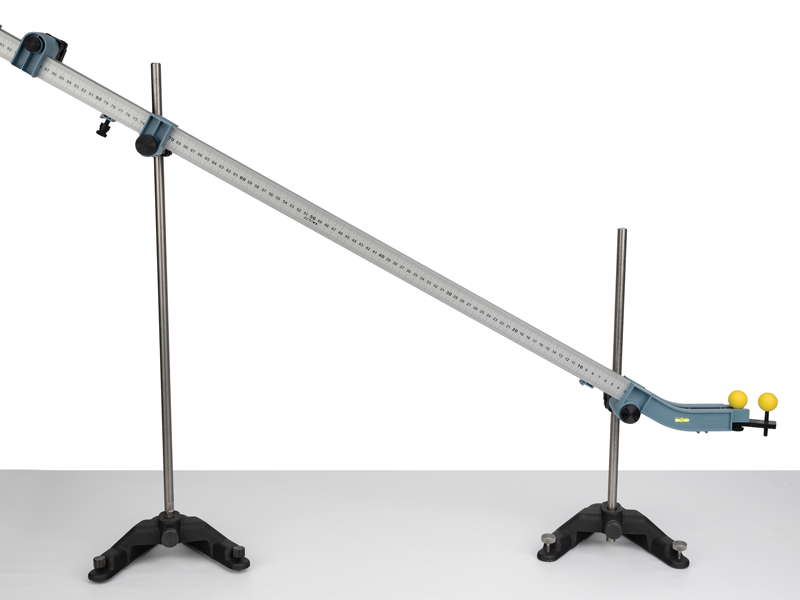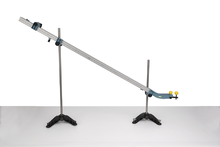Meter Stick Mechanics
This set of experiments allows the user to perform mechanics experiments using the Ball Ramp (ME-7075), Meter Stick Rotation Set (ME-7073), and the Meter Stick Torque Set (ME-7033)
Activities
01) Uniform Acceleration Down an Inclined Plane
Determine how the distance the ball rolls down the plane depends on time and determine how the speed of the ball depends on time.
02) Projectile Motion Using a Ball Ramp
Determine the velocity of a ball at the bottom of the ball ramp by measuring where it hits the floor. Verify that result by measuring the velocity of the ball with photogates.
03) Conservation of Energy of Ball on Ramp
Verify that potential energy is converted to kinetic energy as a ball rolls down a ramp. The kinetic energy includes translational and rotational kinetic energy.
04) Conservation of Momentum in Two Dimensions
A ball rolls down a ramp and collides with a second stationary ball. Confirm that momentum is conserved for elastic collisions in two dimensions.
05) Centripetal Force
Determine how the centripetal force depends on angular velocity, mass, and radius by measuring the force directly with a force sensor.
06) Rotational Inertia of a Point Mass
Determine the rotational inertia of a point mass about a perpendicular axis through center of the circle of rotation. The rotational inertia of a point mass is measured for several different radii.
07) Rotational Inertia of a Thin Rod
Determine the rotational inertia of a thin rod about an axis through center. Use the Parallel Axis Theorem to determine the rotational inertia of a thin rod about an axis that is not through the center.
08) Gravitational Torque
Students set up various systems to learn about gravitational torque and center of mass. They find the mass of an object, determine the mass of a meter stick, predict the location of a mass to balance an off-center meter stick, and locate the center of mass of an irregular object.
09) Analyzing a Static Beam
Students take measurements of various arrangements of a static beam and use them to make predictions about the forces on the beam. A force sensor is used to check their predictions.
10) Exploring Physical Pendulums
Students use a meter stick as a physical pendulum to explore the factors that affect the period and the mathematical properties of the physical pendulum period equation.
11) Exploring a Rotating System
Students construct and collect data with an experimental system to determine angular velocity, angular acceleration, applied torque, and the rotational inertia of the meter stick component.
12) Exploring Torque
Students explore the concepts associated with torque and balance using the Meter Stick Torque Set. They develop the mathematical relationship between the force vector and the position vector by making predictions and testing them.
13) Falling Beam
Students predict the angular velocity of a meter stick that has rotated from the vertical position to the horizontal position. They derive an expression to predict the angular velocity for an arbitrary angle from the horizontal. Students collect data to verify their prediction. They modify the data to create a linear graph and compare the slope to their predicted slope.
14) Static Equilibrium
There are two requirements for an object to be in static equilibrium: The sum of the torques is zero and the sum of the forces is zero. An object is hung from a horizontal meter stick which is suspended from a vertical rod by a string. Summing the torques, the equation is solved for the tension in the string. The tension in the string is also measured directly with the Wireless Force Sensor. By summing the forces, the force at the pivot is determined.



